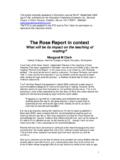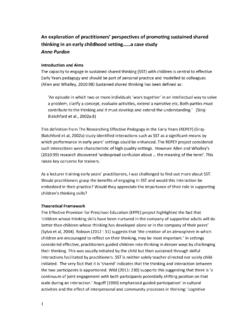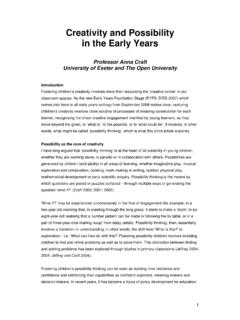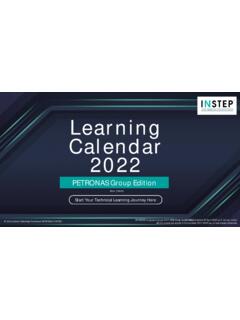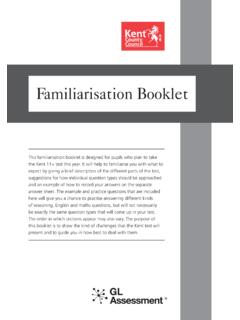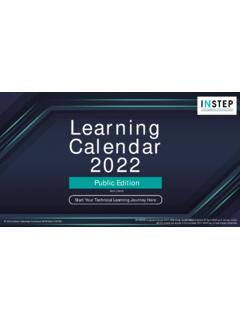Transcription of Early Years Transitions Action Research Project - TACTYC
1 Early Years Transitions Action Research Project Guiding the Journey (Can using Transitions story guides support parents and children in understanding their transition journeys?) Page 1 of 11 Sue Johnson INTRODUCTION The purpose of this Action Research Project was to investigate the use of Transitions story guides to support parents and children in their understanding of their Transitions journeys into a sessional, term time Early Years setting and on to reception classes in a mainstream primary school. The Project also formed part of a local authority Early Years transition Action Research Project which utilised the Five bridges of transition (Galton et al.)
2 1999, Barber 1999) to encourage Early Years settings (including reception classes in schools) to reflect and develop upon existing practice and children s engagement and achievement in order to sustain children s progress towards good EYFS profile outcomes. The Project used Action Research principles to reflect on the setting s existing Transitions practice predominantly within the remit of the Five Bridges Personal and Social Bridge (Galton et al. 1999, Barber 1999) and in the development of new practices strategies and sought to determine the efficacy of using a transition story guide as a complementary teaching strategy to those already in use by asking the following question: Can using Transitions story guides support parents and children in understanding their transition journeys?
3 THEORETICAL FRAMEWORK It isn't the changes that do you in, it's the Transitions . They aren t the same thing. Change is situational: the move to a new site, the retirement of the founder, the reorganization of the roles on the team, the revisions to the pension plan. transition , on the other hand, is psychological; it is a three-phase process that people go through as they internalize and come to terms with the details of the new situation that the change brings about. (Bridges 2009, p3) According to Bridges (2009) Transitions are processes that start with an ending and end with a beginning.
4 Moreover he suggests that managing Transitions involves helping individuals pass through three transitional phases; the ending phase, the neutral zone (Bridges 2009, p5), and the third and final phase of new beginnings which Bridges (2009) suggests enables individuals begin to develop their new identities, discover a new sense of purpose and energy and being to make the change work. The term Transitions is generally associated with change and readjustment and can relate to many key periods and/or specific events that happen during the course of a person s life.
5 Transitions can be both horizontal and vertical. Johansson (2007) believes that for today s children horizontal Transitions are a part of everyday life involving the changes and adjustments that children make when, for example, going from home to nursery, from Early Years Transitions Action Research Project Guiding the Journey (Can using Transitions story guides support parents and children in understanding their transition journeys?) Page 2 of 11 Sue Johnson nursery to swimming lessons or gym club and then from these recreational activities back to home.
6 Within the Early Years care and education sector however the term transition is frequently used to mark those occasions when children begin accessing or transferring between non home based childcare settings such as nurseries, pre-schools or schools. Vogler et al. (2008) suggests that within a predominantly Western culture children s chronological age is used as a powerful delineator of childhood stages. This is particularly true in the context of the Transitions into and out of the setting which are determined by the conditions of the setting s registration which means that children join the setting aged between 2 and 3 Years old and the local authority policy of providing mainstream reception classes that children join in the September following their 4th birthday.
7 FIVE BRIDGES The Five bridges of transition are based on the five pivotal issues identified in respect of Transitions and transfers by Galton et al. (1999) and expanded on by Barber (1999) who likened the divide between Primary and Secondary schools as a muddy river. Barber (1999) suggested that schools to build bridges to enable a smooth crossing. He referred to the five headings as used by Galton et al. (1999) (bureaucratic, personal and social, curriculum, pedagogic and management of learning) as the Five Bridges and considered the development of these bridges to be essential to ensuring children s smooth transition or transfer.
8 REFLECTIONS ON EXISTING PRACTICES SUMMARY Research shows that parental involvement in a child s Early education and care experiences has significant long term benefits and can ultimately improve a child s educational and developmental outcomes (Department for Education and Skills (DFES) 2002, DFES 2003b, Sylva et al. 2004, DFES 2005, Department for Children, Schools and Families (DCSF) 2007). Reflections in respect of the setting s current practices suggested that there were many opportunities for parents to participate in the more administrative aspects of their children s Transitions ; however it was recognised that there were limited opportunities for parents to engage with their children in helping them prepare for their Transitions either into the setting or on to mainstream school.
9 It was also recognised that whilst most children attend setting visits and settling-in sessions they were not given many opportunities to actively participate in their transition journeys or prepare for Transitions either into the setting or on to mainstream schools. Early Years Transitions Action Research Project Guiding the Journey (Can using Transitions story guides support parents and children in understanding their transition journeys?) Page 3 of 11 Sue Johnson Moreover children s preparation for transition was also significantly disadvantaged by the term time nature of the setting and mainstream schools.
10 Whilst the setting s practice of providing pre-autumn term settling-in sessions immediately prior to the beginning of the autumn term had gone some way to negate the impact of the six week summer break between the summer and autumn terms there was still a significant time period that could be used to help children prepare for their transition into the setting. It was also identified that for children transiting to mainstream school the six week summer break was often more problematic, especially given that there is currently no single common transition induction method for children entering mainstream schools.

